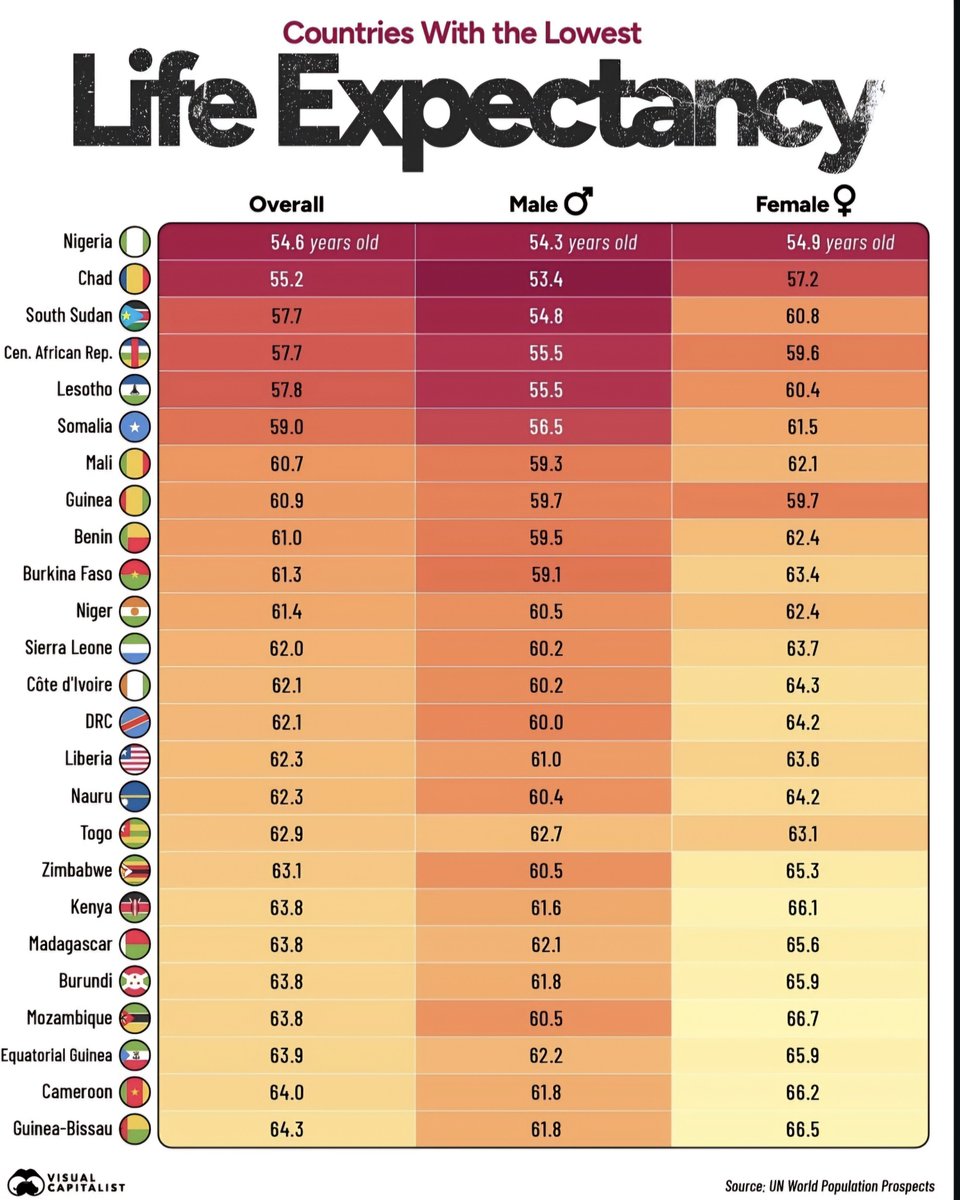Select Language:
Image:

5 Countries with the Shortest Average Lifespans in 2025
Nigeria: Struggling with Limited Lifespans
Nigeria tops the list of countries with the lowest life expectancy globally, averaging just 54.6 years. Males in Nigeria typically live around 54.3 years, while females slightly outlive them at approximately 54.9 years. The nation’s health infrastructure faces significant challenges, including limited access to quality healthcare, widespread poverty, and high disease burdens such as malaria and HIV/AIDS.
Chad: Endemic Poverty and Healthcare Shortfalls
Chad ranks closely behind Nigeria with an average lifespan of 55.2 years. The disparity between male (53.4 years) and female (57.2 years) life expectancies highlights gender differences in survival. With ongoing conflicts, poverty, and insufficient health services, Chad remains one of the most challenging countries for longevity.
South Sudan: A Young Nation Facing Health Crises
South Sudan’s average life expectancy is approximately 57.7 years. Its fragile political stability, ongoing conflict, and prevalence of infectious diseases have massively impacted health outcomes. Male life expectancy stands at 54.8 years, with females slightly better at 60.8 years.
Central African Republic: Battling Disease and Instability
The Central African Republic (CAR) finds itself with an average lifespan of only 57.7 years. Limited healthcare resources, ongoing violence, and economic hardships have hindered efforts to improve health, particularly affecting vulnerable populations.
Lesotho: Economic Challenges and Healthcare Access
With an average life expectancy of 57.8 years, Lesotho faces similar health system challenges. Women tend to live longer (60.4 years) than men (55.5 years), likely due to differences in exposure to risk factors and healthcare access.
The South Sudan Effect: A Closer Look at Africa’s Struggles
The entire African continent features prominently in this list, with many countries ranking among the lowest globally. Factors such as conflicts, poverty, malnutrition, limited healthcare infrastructure, and infectious diseases like HIV/AIDS and malaria contribute heavily to the low life expectancies. Countries such as Somalia, Mali, and Guinea are among those with slightly higher averages, yet still within the bottom tier worldwide.
The Impact of Conflict and Poverty on Life Expectancy
In nations experiencing ongoing conflicts, life expectancy often correlates with stability. For example, Somalia’s average lifespan is around 59.0 years, and similar patterns emerge in countries like Niger and Burkina Faso. The disruption of health services, displacement, and food insecurity have devastating consequences.
Female Longevity Slightly Outpaces Males in Low-Income Countries
Across the listed nations, females generally tend to live longer than males, although the gap remains small or inconsistent. For instance, in Guinea and Benin, females outlive males by approximately 3 years on average, while in some countries such as Togo, the difference is negligible.
Regional Disparities and Future Outlook
While these figures highlight the grim realities of health in the world’s poorest countries, there is cautious optimism that ongoing international development efforts, vaccination programs, and investments in healthcare infrastructure could improve life expectancy in these regions over the coming decades.
Countries with the Lowest Average Life Expectancy in 2025
| Rank | Country | Overall Life Expectancy | Male | Female |
|---|---|---|---|---|
| 1 | Nigeria | 54.6 | 54.3 | 54.9 |
| 2 | Chad | 55.2 | 53.4 | 57.2 |
| 3 | South Sudan | 57.7 | 54.8 | 60.8 |
| 4 | Central African Republic | 57.7 | 55.5 | 59.6 |
| 5 | Lesotho | 57.8 | 55.5 | 60.4 |
Source: UN World Population Prospects 2025
The Stark Realities: Why Do These Countries Fare Worse?
The underlying causes contributing to these low life expectancies are complex and multifaceted. Factors include:
- Health Infrastructure Gaps: Limited access to hospitals, medicines, and preventive care.
- Economic Instability: Poverty hampers health, nutrition, and access to clean water.
- Conflicts and Displacement: Violence and civil wars exacerbate health crises.
- Infectious Diseases: High prevalence rates of HIV/AIDS, malaria, and other communicable diseases.
- Environmental Challenges: Droughts, floods, and poor sanitation impact community health.
Moving Forward: What Can Be Done?
International agencies and governments are actively working to address these issues through:
- Healthcare Improvements: Building hospitals, training health workers, and increasing vaccine coverage.
- Economic Development: Promoting sustainable farming, education, and economic resilience.
- Conflict Resolution: Stabilizing regions to create safer environments conducive to health initiatives.
- Disease Control Programs: Enhanced efforts to combat infectious diseases through vaccination, testing, and treatment.
While this list underscores the ongoing struggles in some of the world’s most vulnerable countries, concerted global effort and targeted investments hold the promise of extending lifespans and improving quality of life for future generations.
Note: The information compiled is based on the latest data from the UN World Population Prospects 2025 and reflects current trends in global health disparities.







